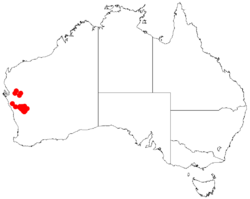Biology:Acacia incognita
| False sugar brother | |
|---|---|
| Scientific classification | |
| Kingdom: | Plantae |
| Clade: | Tracheophytes |
| Clade: | Angiosperms |
| Clade: | Eudicots |
| Clade: | Rosids |
| Order: | Fabales |
| Family: | Fabaceae |
| Subfamily: | Caesalpinioideae |
| Clade: | Mimosoid clade |
| Genus: | Acacia |
| Species: | A. incognita
|
| Binomial name | |
| Acacia incognita Maslin & Buscumb
| |

| |
| Occurrence data from AVH | |
Acacia incognita, also known as false sugar brother,[1] is a shrub or tree belonging to the genus Acacia and the subgenus Juliflorae that is endemic to Western Australia.
Description
The shrub or tree typically grows to a height of 3 to 5 m (9.8 to 16.4 ft) and has an obconic form. It has slightly crooked stems that are not fluted with fissured on present on the main stems and the upper branches. It has resinous new shoots with scattered reddish glandular hairlets. The glabrous branchlets can have some hairs between the non-resinous ribs. Like most species of Acacia it has phyllodes rather than true leaves. The green to grey-green and slender phyllodes are coarsely pungent and have a straight to shallowly incurved shape with a length of 4 to 12 cm (1.6 to 4.7 in) and a width of 1 to 1.5 mm (0.039 to 0.059 in) with fine longitudinal nerves.[1] It blooms inconsistently between January and October producing simple inflorescences that occur singly or, less frequently, in pairs in the axils and have spherical to short-obloid shaped flower-heads that have a length of 4 to 6 mm (0.16 to 0.24 in) and a diameter of 4 to 5 mm (0.16 to 0.20 in). The thinly coriaceous to crustaceous seed pods are straight to shallowly curved with a length of 3.5 to 10 cm (1.4 to 3.9 in) and a width of 1 to 2 mm (0.039 to 0.079 in) with longitudinal nerves. The shiny brown seeds found in the pods have a narrowly elliptic or oblong shape have a length of 3 to 5 mm (0.12 to 0.20 in) with a creamy while aril.[1]
Distribution
It is native to an area in the Mid West region of Western Australia[2] from around Mullewa in the west through to around Yalgoo in the east and to around Karara Station to the north of Morawa in the south. It is often situated on plains or low rises growing in loam or loamy clay soils as a part of Eucalyptus woodland communities or Melaleuca shrubland communities.[1]
See also
References
- ↑ Jump up to: 1.0 1.1 1.2 1.3 "Acacia incognita Maslin & Buscumb". Wattle - Acacias of Australia. Lucid Central. https://apps.lucidcentral.org/wattle/text/entities/acacia_incognita.htm. Retrieved 16 March 2020.
- ↑ "Acacia incognita". FloraBase. Western Australian Government Department of Parks and Wildlife. https://florabase.dpaw.wa.gov.au/browse/profile/32117.
Wikidata ☰ Q17438710 entry
 |

